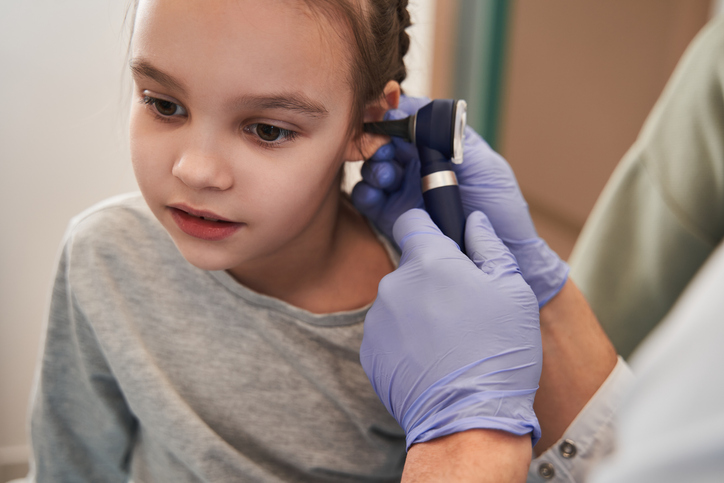Ear infections are common in both children and adults. They occur when the middle ear becomes inflamed, which can be caused by fluid buildup or a bacterial or viral infection. In this article, we’ll look at the causes and symptoms of ear infections, as well as the treatment for ear infection.
Ear Infections Causes
A variety of factors can cause ear infections, including:
- Bacterial or viral infection: As previously stated, the most common cause of ear infections is bacterial or viral infections. Bacteria and viruses can get into the middle ear via the Eustachian tube, which connects the middle ear to the back of the throat. Streptococcus pneumoniae, Haemophilus influenzae, and Moraxella catarrhalis are common bacteria that cause ear infections. Respiratory syncytial virus (RSV), influenza, and adenovirus are all viruses that can cause ear infections.
- Allergies can cause inflammation and fluid buildup in the middle ear, which can lead to an ear infection. This is common in cases of allergic rhinitis or hay fever, where nasal passage inflammation can spread to the Eustachian tube and middle ear. Allergies can also cause swelling and blockage of the Eustachian tube, making fluid drainage from the middle ear more difficult.
- Changes in air pressure, such as those experienced during air travel or scuba diving, can cause the Eustachian tube to become blocked, resulting in an ear infection. This is because pressure changes can cause the air pressure in the middle ear to become imbalanced, resulting in fluid buildup and an increased risk of infection.
- Buildup of earwax: Earwax is a natural substance that protects the ear canal from dust, dirt, and bacteria. When earwax builds up, it can trap bacteria and cause an ear infection. This is due to the fact that earwax can create a warm, moist environment that encourages bacterial growth. Furthermore, earwax buildup can clog the Eustachian tube, making fluid drainage from the middle ear more difficult.
- Ear infections can be exacerbated by structural abnormalities in the Eustachian tube or the middle ear. For example, if the Eustachian tube becomes abnormally narrow or blocked, fluid draining from the middle ear becomes more difficult. Similarly, if the shape or size of the middle ear is abnormal, it can make it difficult for fluid to flow properly and increase the risk of infection.
Ear Infection Symptoms
An ear infection’s symptoms can vary depending on the severity and cause of the infection. Among the most common symptoms are:
- Pain is often the most noticeable symptom of an ear infection, especially in the middle ear. The pain could be sharp or dull, and it could come and go. Because of the pain, young children may pull at their ears or cry more than usual.
- Fever: Ear infections, especially in children, can cause a fever. The fever can be mild or severe, and it can last for several days.
- Fluid discharge: An ear infection can cause fluid to drain from the ear in some cases. The fluid could be clear, yellow, or bloody. This could indicate that the eardrum has ruptured, which would relieve the pressure and pain but necessitate medical attention.
- Hearing difficulty: A buildup of fluid in the middle ear can result in temporary hearing loss or muffled hearing. This is especially noticeable in children who have trouble understanding speech or responding to sounds.
- Balance issues: Because the inner ear aids in balance, an infection in the inner ear can cause dizziness, vertigo, or a sense of unsteadiness. This is especially noticeable when standing or moving around.
- Ear fullness or pressure: Ear fullness or pressure may indicate an ear infection, especially if it is accompanied by other symptoms such as pain or hearing loss.
It’s important to note that not all ear infections have the same symptoms, and some people may only have a few or none of the above symptoms. If you suspect you or your child has an ear infection, see a doctor right away for a proper diagnosis and treatment.
Ear Infection Treatment
The course of treatment for an ear infection is determined by the cause and severity of the infection. Among the most common treatment options are:
- Antibiotics: Antibiotics may be prescribed to help fight an ear infection caused by bacteria. The antibiotic used will be determined by the specific bacteria causing the infection. Depending on the severity of the infection, antibiotics are typically taken for 5-10 days.
- Pain relievers: Over-the-counter pain relievers such as acetaminophen (Tylenol) or ibuprofen (Advil, Motrin) can help relieve ear infection pain. In some cases, the doctor may recommend stronger pain relievers.
- Ear drops: To help relieve pain and fight infection, ear drops containing a numbing agent or antibiotic may be prescribed. When using ear drops, it is critical to carefully follow the instructions and ensure that the drops reach the infected area.
- Warm compresses: Applying a warm compress to the affected ear can help relieve pain and swelling. It is critical to use a warm, not hot, compress and to avoid placing anything directly in the ear.
- Surgery: Surgery may be required in some cases to treat recurring or severe ear infections. A myringotomy, which involves making a small incision in the eardrum to drain the fluid, is the most common surgical procedure for ear infections.
It’s important to note that not all ear infections necessitate antibiotics or surgery. In many cases, the infection will clear up on its own in a matter of days or weeks. In these cases, over-the-counter pain relievers and warm compresses may suffice to alleviate symptoms. However, if you or your child is experiencing severe pain, a high fever, or other concerning symptoms, you should consult a doctor for a proper diagnosis and treatment.
Ear Infection Prevention
You can help prevent ear infections by doing the following things:
- Regular hand washing and good hygiene can help prevent the spread of viruses and bacteria that cause ear infections. Make sure to thoroughly wash your hands with soap and water before touching your face or handling food.
- Keep your ears dry: Moisture in the ear can foster the growth of bacteria, so it’s critical to keep your ears dry. After swimming or showering, thoroughly dry your ears with a towel or a hair dryer on the lowest setting.
- Irritants should be avoided: Cigarette smoke, pollution, and other irritants can all increase the risk of ear infections. Avoid exposure to these irritants if at all possible, especially if you are prone to ear infections.
- Allergies can cause inflammation in the nasal passages and throat, increasing the risk of ear infections. Antihistamines or nasal sprays used to treat allergies may help reduce the risk of ear infections.
- Sharing utensils or drinking from the same cup as someone who has an infection increases the risk of the infection spreading. Encourage everyone in the family to use their own utensils and cups.
- Obtain a vaccination: Vaccines can aid in the prevention of some of the infections that can cause ear infections. Pneumococcal and influenza vaccines, in particular, are recommended for children and adults who are at high risk of ear infections.
Secure Treatment for Ear Infection Today
If you or your child has symptoms of an ear infection, it is critical that you seek treatment for ear infection from a qualified healthcare provider. Madison Richardson MD is a board-certified physician who specializes in the diagnosis and treatment of ear infections. We can help you or your child feel better and prevent future ear infections with our compassionate care and cutting-edge treatments. Don’t wait until your symptoms worsen; make an appointment with Madison Richardson MD today to get the treatment for ear infection you need.

